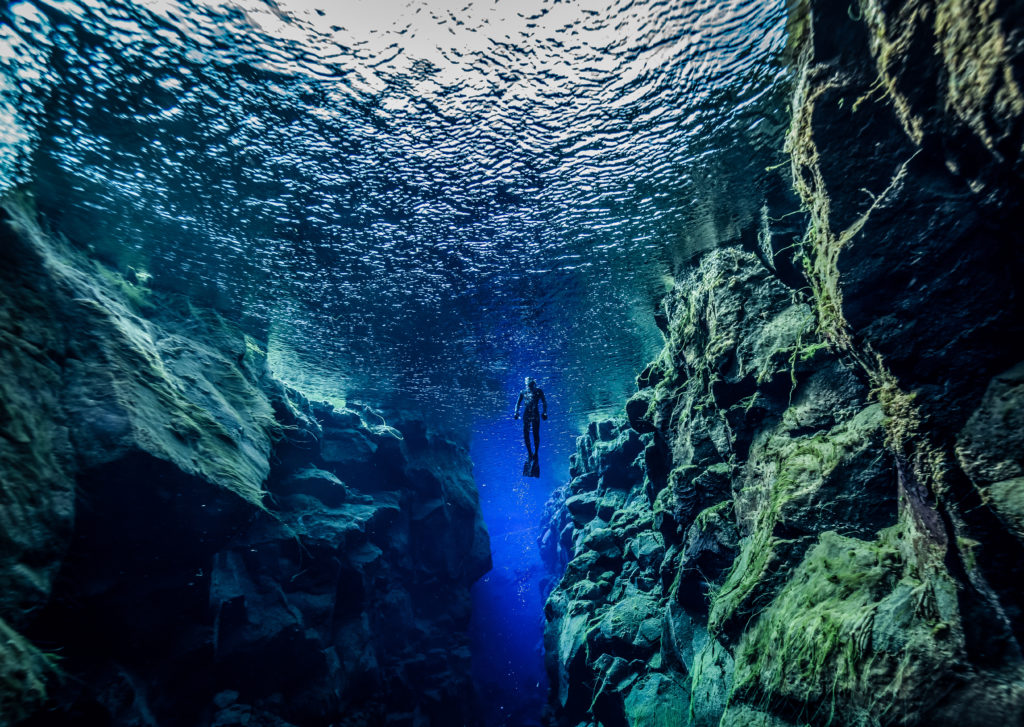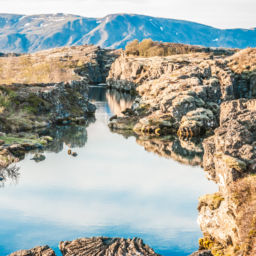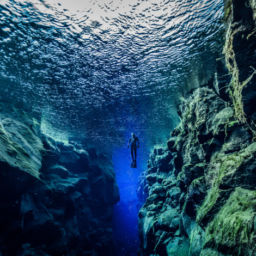In 1789 several earthquakes rattled the Thingvellir area of Iceland, causing a number of fissures. Divers will be most familiar with the Silfra fissure, which cut into a nearby underground spring and lead to the area being filled with glacial meltwater from the Langjökull glacier. Two factors make diving at the Silfra fissure unique. First, the fissure is between the North American and Eurasian tectonic plates, which means when scuba diving in Silfra, you’re technically touching two continents.
The second wow factor at Silfra is the visibility of the water. Dive sites commonly boast of having “the clearest water in the world,” but it may just be true in Silfra. The water in the spring that feeds the Silfra fissure travels 37 miles, or 60 kilometers, before it goes underground and is filtered through 31 miles (50 km) of porous, underground lava. The water is filtered for between 30 and 100 years before it enters the fissure, making it just about the purest, clearest water in the world for diving. That equates to over 325 feet (100 m) of visibility.
Scuba diving in Silfra
Since glacial meltwater fills Silfra, the water temperature is cold — very cold. It remains between 36 and 39 F (2 to 4 C) throughout the year, requiring a drysuit for both diving and snorkeling. Appropriate thermal undergarments, thermal socks, gloves, and hoods will make the dive much more comfortable.
While some cave systems reach down to about 200 feet (60 m), the allowable maximum dive depth limit is 60 feet (18 m), with an average dive depth of between 23 and 40 feet (7 to 12 m). You cannot dive in the tunnels and caves around Silfra.
The dive site at Silfra changes from time to time as earthquakes can cause boulders and rocks to fall into the fissure. This can also create new tunnels and caverns. More consistently, the tectonic plates are moving away from each other at a rate of 2 centimeters a year, gradually making the crack wider.
What to expect on a dive

There is very little marine life in the Silfra fissure. Mostly, divers will observe different colors of algae, dominated by neon-green algae fondly nicknamed “troll hair.” Arctic char might appear in the Silfra fissure during mating season between August and September, while dwarf char live in the fissure year-round. There might also be a chance to see an indigenous amphipod called Crymostygius thingvallensis found only in Thingvellir Lake and surrounding fissures.
Silfra has four main dive areas, and it’s best to cover them in two dives — although some dive operators only do one dive during winter. While the physical dive site might change from time to time due to earthquakes, the weather can also dramatically change how divers experience the site. On sunny days, sunlight filters through the water, creating mesmerizing patterns on the dark lava rocks, mixed with deep shadows created by the typography.
The dive profile
A dive at Silfra starts off with its main attraction — the crack between the two continents. Here, in Silfra’s narrowest section, divers usually take that iconic picture. The crack is about 390 feet (120 m) long and gently curves left and right. The Hall is a slightly wider section where green “troll hair” algae covers lava stones. Looking up, divers might see local ducks and geese swimming overhead.
The Cathedral is a vast space, about 65 feet (20 m) at its deepest point and 325 feet (100 m) across. Here divers get to experience the pristine visibility provided by the glacial meltwater, even more so if there are divers ahead and you can see the “chandelier effect” created by their bubbles. Silfra Lagoon offers the most spectacular view of the water’s visibility, mixed with colors of blue and green. The phrase “as far as the eye can see” pops to mind here.
Know before you go
There are a few rules and regulations in place to ensure safe diving for all.
- Divers should have an internationally recognized dive certificate (at least open water).
- You must dive in a drysuit (wetsuits are not allowed).
- Divers should have a drysuit specialty certification from an internationally recognized organization. Alternatively, divers must have completed at least 10 logged drysuit dives in the two years prior to the Silfra dive. An instructor from an internationally recognized organization should sign off on these dives.
- Minimum age for divers is 17 years old.
- You cannot dive in caves and overhead environments around Silfra.
- Maximum depth allowed is 60 feet (18 m).
- The ratio of divers to dive guide should not exceed 3:1.
- Tour operators must ensure that divers can swim and are medically fit for the dive.
- Divers should be between 4’9” and 6’5” tall (150 to 200 cm) and weigh between 99 and 265 pounds (45 and 120 kg).
Solo or independent diving is not allowed at Silfra — you must go through a local dive company. Safety in the area is taken very seriously, as is diver comfort and experience. With thousands of divers traveling to dive between two continents each year this is hardly surprising.
For those unexcited about cold-water diving, perhaps the promise of “the best visibility in the world” and the chance to dive between two continents can convince you. If not, there is always the promise of hot chocolate and cookies waiting for you when it’s over.



